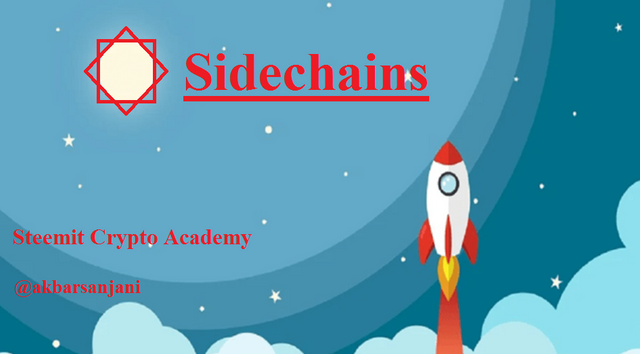Sidechains - Crypto Academy / S4W8 - Homework Post for Professor @pelon53

Good night everyone, steemians, blogers, readers, and crypto lovers. I will start a positive activity tonight because life must always be productive and tonight I will write a post about cryptocurrency on my blog to participate in the Steemit Crypto Academy Season 4. This is week 8 of Season 4 and the third class I will be taking. follow this week is professor @pelon53's class. In this class, we will learn and share knowledge about “Sidechains” based on the following questions.
Question 1:
Explain the Sidechains ZK-Rollups

ZK-Rollups are Sidechains capable of overcoming scalability and commission fees on the Ethereum network. ZK-Rollups is able to group a number of transactions in one transaction record and the number of these transactions may reach hundreds or thousands of transactions. Sidechains are also referred to as Layer 2 while Layer 1 is the main blockchain and thus Layer 2 allows to extend the functionality of Layer 1 which is executed by creating structures that work on Layer 1. ZK-Rollups will receive a number of information sent by a number of parties and when all the data has been completed then the information will be sent to the main network as an important archive on the blockchain network.

ZK-Rollups are run by the SNARK cryptographic system which makes these Sidechains have a good standard of security, speed, anonymity. The public can prove ownership without the need to change or delete the data containing the information. Users in the case of ZK-Rollups are grouped into two participants, namely transactors and relayers. Users who make transfers to the network are referred to as transactors. The data transferred consists of the number of transactions, the address of the sender and recipient address, the commission fee, and the nonce number for the verification process. To complete the transaction, the smart contract will create a number of transaction data records on the Merkel Tree in one address. While Relayers will take a number of transactions to create a Rollup. There are a number of projects within the ZK-Rollups environment, such as Aztec, Optimism, Starkware, Zksync, Loopring, Fuel, and Arbitrum.
ZK-Rollups has a number of advantages, such as offering lower transaction fees, blocks are ordered in parallel with a decentralized system, tend to be faster when compared to other competitors, allows for increased throughput because Layer 2 has less data than Layer 1 , and does not require special verification. However, ZK-Rollups also have drawbacks that need to be considered, such as some consider it to have poor security because it does not require special verification, the initial configuration uses a centralized system, it is difficult to know zero recognition, and most of the transactions are simple.

Question 2:
Explain the Sidechain Liquid Network

In 2017 the Canadian company Blockstream succeeded in developing the Liquid Network Sidechain which is very useful on the Bitcoin network because users can make transactions with high speed, good security, and more privacy. By using the Liquid Network, transactions can be made from two directions, peg-in and peg-out. Peg-in allows users to transfer from the main network to the Liquid Network and Peg-out allows users to transfer from the Liquid Network to the main network. The Bitcoin transaction that occurs in this case requires 102 confirmations and the Bitcoin used in the Liquid Network is called L-BTC whose value is pegged to the original BTC value.

Liquid Network operates on an open source platform called Elements whose operations are regulated by the Member Federation. In its operation, Liquid Network uses the Strong Federation consensus and this is used to replace the expensive PoW (Proof of Work) mechanism. In its operations, Liquid Network also has two important officials, namely Blocksigner and Watchmens. Blocksigners are in charge of managing the chain while Watchmens are in charge of securing Bitcoins on the network.
Liquid Network has a number of advantages such as transactions can be completed in two minutes, allows users to create new tokens, the use of L-BTC is very user-friendly, new blocks can be generated every minute, and you can maintain your privacy if you want. Besides Liquid Network, currently it has a number of products that can be used, such as Blockstream Finance/Mining/Energy, Blockstream AMP, E-Lightning, and many more. This current blockstream has also collaborated with a number of well-known platforms such as BitMEX, Huobi, BTSE, and many more.

Question 3:
Describe the steps to connect the Metamask wallet and the Polygon network wallet. (Show screenshots)
- Visit https://polygon.technology/ and click Polygon Wallet located on the Use Polygon menu.

- Click Connect Wallet in the upper right corner.

- Select Metamask on the pop-up menu.

- CliCk Next on pop-up menu.

- Then click Connect.

- Then click Sign as the last condition to complete this.

- Return to the main Polygon Wallet page. The Metamask wallet application has been successfully installed in the upper right corner of the page.


Question 4:
According to the Polygonscan block explorer, when will the block 25,000,000 be generated? (Show screenshot). Explore the 12,000,000 block, at that time, what was the price of the Matic? (Show screenshots)
- Visit https://polygonscan.com/ and type 25000000 in the search field.

- Countdown for Block 25000000 is 107 Days 6 Hour 3 Minutes 29 Seconds.

- Type 12000000 in the search field.

- Below is the detailed information for Block 12000000 and the price of the MATIC coin at that time was $0.38.


Conclusions
Technology continues to evolve and innovation continues, including in the world of blockchain and cryptocurrencies. Sidechains are present as an alternative to solve scalability problems that generally occur in blockchain networks. The Liquid Network acts as Sidechains on the Bitcoin network while the Sidechains for the Ethereum network are ZK-Rollups. The main advantages of the two sidechains are that they can process hundreds of transactions in one transaction, reduce congestion on the network, and are able to minimize commission fees on the network.

#club5050 😀